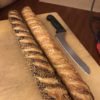In 1902, a scientist had a grain of an idea: a gun that would take the tiny bit of moisture within a rice or other grains, turn it to steam, and “puff” that grain up into a crispy precursor to the contents of a modern cereal box. MOFAD, a group seeking to establish a museum of food and drink, showed off a grain cannon at a recent Brooklyn event. MOFAD’s research coordinator, Emma Boast, and founder, food scientist Dave Arnold, gave Brendan a “100% legit” peek into food history.

Emma Boast: So, the basic principle behind puffing is, you’re taking moisture that is inside starch and allowing that to escape as steam. And when that steam escapes from cooked starch, the structure kind of explodes. And as the steam is flashing off, that’s what causes things to puff essentially.
Brendan Francis Newnam: And so that’s basically what would take a dry piece of rice and turn it into puffed rice.
Emma Boast: Right, and I mean even dry rice has a little bit of moisture in it, and what happens is when you put that inside the puffing machine, you seal the puffing machine, the moisture starts to boil basically, but it can’t escape as steam. When you then whack the lid of the puffing machine and puff, that steam flashes off immediately and the pressure drop that happens causes that puff to happen.
Brendan Francis Newnam: About how wide is it, and how tall is it?
Emma Boast: It’s about 7 feet long, 4 feet wide, and maybe about 3 feet tall.
Brendan Francis Newnam: And it’s got this cool wheel thing in the middle that rotates. Why does it do that?
Emma Boast: Right, so the rotation is to prevent the starch that’s inside from scotching. If it all just stayed in one place it would burn, because the barrel of the machine is very hot.
Brendan Francis Newnam: How are you heating it up?
Emma Boast: We actually have propane. Usually you would use a natural gas in a commercial setting, but because we’re doing this in a mobile context, we’re using propane tanks.
Brendan Francis Newnam: Do you know where the first one was created, and who did it?
Emma Boast: I do, yeah. The puffing process was discovered by a scientist named Alexander Anderson around the turn of the century in 1902, and he was a botanist actually, and was studying the structure of starch containing plants, like grains, beans, etc. And he was working actually in New York at the Botanical Gardens and was investigating the theory that basically starch had a little bit of moisture in it, but hadn’t been proven.
And he realized that if I seal the starch in a closed environment and heat it, that moisture should turn to steam. And if I break that, and if it puffs, or it expands, that will prove that starch has this moisture. So, he started using small glass test tubes filled with flour and corn starch.
He would put those in an oven, and then break them with a hammer basically, and they would explode. It was very dangerous. He’s really credited as being the sort of grandfather of puffing.
Brendan Francis Newnam: Grandfather of puffing. That’s a great title.
Emma Boast: Right, he actually sold the patent to this process to Quaker, which was a big milling company at the time, and they were really producing hot breakfast cereals. I mean oatmeal is of course what we’re all familiar with. But they hadn’t really moved into the so called ready to eat cereal market.
Brendan Francis Newnam: And the rest is cereal history.
Emma Boast: Yeah, Anderson himself actually had this idea that a great way to debut this product, which hadn’t really been commercially introduced yet, would be at a World’s Fair, and so he had 8 bronze cylinders. Sometimes the literature says they were actual cannons. We think they were actually just metal cylinders, where he would fill them with rice and basically puffed all of this rice into a large metal cage, very similar to what we’re doing now.
Brendan Francis Newnam: Alright, well I want to watch the cage get filled up with puffed rice, so I’m gonna wander over and try to talk with Dave. That would be Dave Arnold, the president of MOFAD. He looks like, he’s over by the puffing machine. He looks like he’s preparing to puff. Thanks so much for chatting with me.
Emma Boast: Thank you.
Brendan Francis Newnam: Hey David. So what’s going on here with you and the gun.
Dave Arnold: See the gauge over there? We have a pressure gauge. So Peter and I are just checking the pressure gauge and when it gets to about 130 PSI, the temperature is good because it’s gonna keep riding up, then we’re gonna stop the gas, then we’re gonna stop the motor, let it spin until the door is facing down, put the brake on, then hit it with this big heavy old stick, and boom.
Brendan Francis Newnam: Is this how it was done? Was there a big heavy old, like lots of big heavy old sticks back in the day?
Dave Arnold: This is 100 percent legit. So what would happen commercially is someone, one operator would handle several of these guns at a time, and they’d just be going between and firing them, loading them, firing them, loading them. But this is actually how cereal was produced commercially for decades.
Brendan Francis Newnam: It sounds like a lot of fun, that would have been a great job.
Dave Arnold: Eh, well it’s probably like anything like this is probably fun for the first day or so. But you know, probably you know, 10 hours a day, 5-6 days a week, it’d probably get old after a while.
Brendan Francis Newnam: Wasn’t there an easier way then to do this? I mean, why was this the method that they chose?
Dave Arnold: This actually was the easiest way. This was superseded later by two different techniques. Extrusion, direct extrusion puffing and then they made what was called a continuous puffer, which is a continuous version of this, so that an operator could just sit and watch the machine and it would continuously go. When the needle hits the next line, we’re gonna cut it. We’re about to do it.
Brendan Francis Newnam: Alright, I’m gonna step down then.
Dave Arnold: Gas off! Fire in the hole!
Brendan Francis Newnam: Are you happy with the rice?
Dave Arnold: Yeah, see look at here. All this stuff looks good, like the temperature we fired it at was right.
Brendan Francis Newnam: It does look like cereal.
Dave Arnold: Right, it is. Yeah, no, it’s legit.
Brendan Francis Newnam: Now it’s time for the mini marshmallows.


